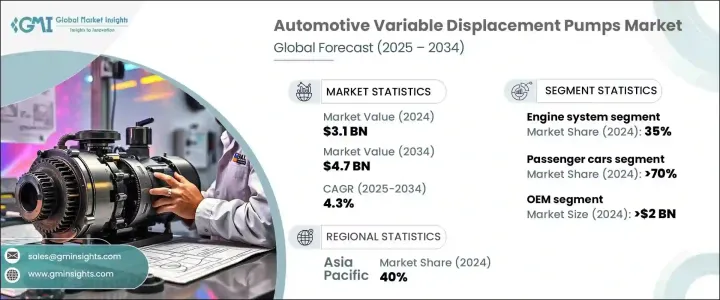
자동차 가변 용량 펌프 세계 시장 규모는 2024년에 31억 달러로 평가되었고, 2025년부터 2034년에 걸쳐 CAGR 4.3%를 나타낼 것으로 예측됩니다.
엄격한 배기가스 규제와 소비자 선호도의 진화로 인해 저연비 친환경 자동차에 대한 수요가 증가하고 있습니다. 세계 각국의 정부는 이산화탄소 배출량을 줄이고 에너지 효율적인 운송을 촉진하기 위해 보다 엄격한 법률을 시행하고 있으며, 자동차 제조업체는 자동차에 선진 기술을 통합할 필요가 있습니다. 가변 용량 펌프는 엔진 성능을 최적화하고 연비를 향상시키고 에너지 손실을 최소화하는 중요한 솔루션으로 부상하고 있습니다.

자동차 제조업체가 지속가능성 목표 달성에 주력하고 있는 가운데 하이브리드차와 저연비차가 보급되어 이러한 시스템 수요를 더욱 밀어 올리고 있습니다. 소비자는 점점 더 연비를 우선시하고 있으며 제조업체는 규제 기준에 맞는 에너지 효율적인 구성 요소를 채택하는 것이 필수적입니다. 에너지 최적화의 필요성은 또한 차량 설계의 혁신을 가속화하고 세계적인 지속가능성 벤치마크를 충족하면서 성능을 향상시키는 새로운 방법을 모색하도록 제조업체에게 촉구하고 있습니다. 연료 가격이 상승하고 하이브리드 자동차와 전기자동차로의 전환이 진행됨에 따라 가변 용량 펌프는 현대 자동차 공학에서 중요한 역할을 수행하고 있습니다. 연료 효율을 계속 중시함으로써 업계 각 사는 큰 성장 기회를 가져오고 향후 수년간 가변 용량 펌프의 지속적인 시장 수요를 확보하게 됩니다.
| 시장 범위 | |
|---|---|
| 시작 연도 | 2024년 |
| 예측 연도 | 2025-2034년 |
| 시작 금액 | 31억 달러 |
| 예측 금액 | 47억 달러 |
| CAGR | 4.3% |
시장은 차종별로 승용차와 상용차로 구분되며, 2024년 시장 점유율은 승용차가 70%를 차지했습니다. 이 부문은 2034년까지 30억 달러를 창출할 것으로 예상됩니다. 하이브리드 자동차와 저연비 차량의 채용이 증가하고 있기 때문에 효율성과 기능성을 향상시키는 고급 자동차 부품 수요가 높아지고 있습니다. 가변 용량 펌프는 하이브리드 차량의 성능을 최적화하고 비유압 응용 분야에서 불필요한 유체 교체를 줄이고 전반적인 연료 관리를 강화하는 데 매우 중요합니다. 이러한 펌프는 에너지 소비를 조정하는 데 도움이 되며 자동차 제조업체는 차량 성능을 저하시키지 않으면서 보다 엄격한 연비 요건을 충족할 수 있습니다.
시장은 또한 용도별로 엔진 시스템, 변속기 시스템, 파워 스티어링 시스템, 연료 관리 시스템, 브레이크 시스템 등으로 분류됩니다. 2024년 시장 점유율은 엔진 시스템이 35%를 차지하고 가변 용량 펌프가 내연 엔진 성능 최적화에 중요한 역할을 하고 있습니다. 이러한 펌프는 유체 흐름을 조정하여 연료 소비를 조정하고 엄격한 배출 가스 규정에 대한 적합성을 보장하면서 전반적인 효율을 향상시킵니다. 자동차 제조업체는 이 기술을 활용하여 보다 연비 효율이 높은 엔진을 설계하고 있으며, 지속가능성과 고성능을 중시하는 경향이 강해지고 있는 업계에서 경쟁 우위성을 발휘하고 있습니다.
아시아태평양의 자동차 가변 용량 펌프 시장은 2024년에 40%의 압도적 점유율을 차지해 중국이 이 지역의 성장을 견인하고 있습니다. 저연비의 상용차에 대한 수요 증가가 특히 연료 소비량의 삭감이 최우선 사항인 수송 및 로지스틱스 분야에서의 펌프 채용을 뒷받침하고 있습니다. 이 지역에서는 상용차가 대량으로 운행되고 있기 때문에 고급 엔진 최적화 솔루션에 대한 요구는 전례 없이 높아지고 있습니다. 제조업체는 차량이 높은 운전 성능을 확보하면서 연비 규제를 준수할 수 있도록 혁신적인 펌프 기술에 많은 투자를 하고 있습니다.
The Global Automotive Variable Displacement Pumps Market was valued at USD 3.1 billion in 2024 and is projected to grow at a CAGR of 4.3% between 2025 and 2034. The demand for fuel-efficient and environmentally friendly vehicles is increasing, driven by stringent emission regulations and evolving consumer preferences. Governments worldwide are enforcing stricter laws to lower carbon footprints and promote energy-efficient transportation, compelling automakers to integrate advanced technologies into their vehicles. Variable displacement pumps are emerging as a key solution, optimizing engine performance, enhancing fuel economy, and minimizing energy losses.

As automakers focus on achieving sustainability goals, hybrid and fuel-efficient vehicles are gaining traction, further boosting demand for these systems. Consumers are increasingly prioritizing fuel economy, making it imperative for manufacturers to adopt energy-efficient components that comply with regulatory standards. The need for energy optimization is also accelerating innovation in vehicle design, encouraging manufacturers to explore new ways to enhance performance while meeting global sustainability benchmarks. With rising fuel prices and a shift towards hybrid and electric vehicle adoption, variable displacement pumps are poised to play a crucial role in modern automotive engineering. The continued emphasis on fuel efficiency presents significant growth opportunities for industry players, ensuring sustained market demand for these pumps in the years ahead.
| Market Scope | |
|---|---|
| Start Year | 2024 |
| Forecast Year | 2025-2034 |
| Start Value | $3.1 Billion |
| Forecast Value | $4.7 Billion |
| CAGR | 4.3% |
The market is segmented by vehicle type into passenger and commercial vehicles, with passenger cars accounting for 70% of the total market share in 2024. This segment is expected to generate USD 3 billion by 2034. The increasing adoption of hybrid and fuel-efficient vehicles is propelling the demand for advanced automotive components that improve efficiency and functionality. Variable displacement pumps are crucial in optimizing hybrid vehicle performance, reducing unnecessary fluid displacement in non-hydraulic applications, and enhancing overall fuel management. These pumps help regulate energy consumption, allowing automakers to meet stricter fuel efficiency requirements without compromising vehicle performance.
The market is also classified by application into engine systems, transmission systems, power steering systems, fuel management systems, and brake systems, among others. Engine systems held a 35% market share in 2024, with variable displacement pumps playing a critical role in optimizing internal combustion engine performance. These pumps adjust fluid flow to regulate fuel consumption, improving overall efficiency while ensuring compliance with stringent emissions regulations. Automakers are leveraging this technology to design more fuel-efficient engines, giving them a competitive edge in an industry increasingly focused on sustainability and high performance.
The Asia Pacific automotive variable displacement pumps market held a dominant 40% share in 2024, with China leading the region's growth. The rising demand for fuel-efficient commercial vehicles is driving the adoption of these pumps, particularly in transportation and logistics sectors where reducing fuel consumption is a top priority. With an extensive fleet of commercial vehicles operating in the region, the need for advanced engine optimization solutions is stronger than ever. Manufacturers are heavily investing in innovative pump technologies to help vehicles comply with fuel efficiency regulations while ensuring high operational performance.